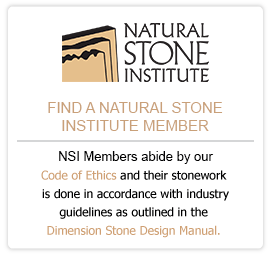How To Clean Stains From Raw Bluestone Hearth
Stain Removal


Spills and Stains
Absorb the spill with a paper towel immediately. Don't wipe the area, it will spread the spill. Flush the expanse with plain h2o and mild soap and rinse several times. Dry out the expanse thoroughly with a soft cloth. Repeat as necessary. If the stain remains, refer to the section in this brochure on stain removal.
Stain Removal
Identifying the blazon of stain on the stone surface is the key to removing it. If you don't know what caused the stain, play detective. Where is the stain located? Is it near a plant, a food service expanse, an area where cosmetics are used? What color is it? What is the shape or pattern? What goes on in the surface area around the stain? Surface stains tin often be removed by cleaning with an appropriate cleaning product or household chemic. Deep-seated or stubborn stains may crave using a poultice or calling in a professional. The following sections draw the types of stains that yous may take to deal with and appropriate household chemicals to utilize and how to prepare and utilise a poultice to remove the stain.
Types of Stains and First Step Cleaning Actions
OIL-BASED
(grease, tar, cooking oil, milk, cosmetics)
An oil-based stain will darken the stone and unremarkably must be chemically dissolved and then the source of the stain can be flushed or rinsed away. Make clean gently with a soft, liquid cleanser with bleach OR household detergent OR ammonia OR mineral spirits OR acetone.
ORGANIC
(coffee, tea, fruit, tobacco, paper, food, urine, leaves, bawl, bird droppings) May crusade a pinkish-brown stain and may disappear after the source of the stain has been removed. Outdoors, with the sources removed, normal sunday and pelting action will generally bleach out the stains. Indoors, clean with12% hydrogen peroxide (pilus bleaching strength) and a few drops of ammonia.
METAL
(fe, rust, copper, bronze)
Atomic number 26 or rust stains are orange to brown in colour and follow the shape of the staining object such equally nails, bolts, screws, cans, flower pots, metal furniture. Copper and bronze stains appear equally light-green or muddy-brownish and consequence from the activity of wet on nearby or embedded bronze, copper or brass items. Metal stains must be removed with a poultice.(Run into section on Making & Using a Poultice) Deep-seated, rusty stains are extremely hard to remove and the stone may be permanently stained.
BIOLOGICAL
(algae, mildew, lichens, moss, fungi)
Make clean with diluted (one/ii cup in a gallon of h2o) ammonia OR bleach OR hydrogen peroxide. Exercise NOT MIX BLEACH AND AMMONIA! THIS COMBINATION CREATES A TOXIC AND LETHAL GAS!
INK
(magic marker, pen, ink)
Clean with bleach or hydrogen peroxide (light colored stone but!) or lacquer thinner or acetone (dark stones only!)
PAINT
Small amounts can be removed with lacquer thinner or scraped off carefully with a razorblade. Heavy paint coverage should be removed only with a commercial "heavy liquid" pigment stripper available from hardware stores and paint centers. These strippers commonly comprise caustic soda or lye. Do not use acids or flame tools to strip paint from stone. Pigment strippers can etch the surface of the stone; re-polishing may be necessary. Follow the manufacturer's directions for employ of these products, taking care to flush the surface area thoroughly with clean h2o. Protect yourself with rubber gloves and eye protection, and work in a well-ventilated surface area. Use just wood or plastic scrapers for removing the sludge and curdled paint. Unremarkably, latex and acrylic paints will not crusade staining. Oil-based paints, linseed oil, putty, caulks and sealants may crusade oily stains. Refer to the department on oil-based stains.
WATER SPOTS AND RINGS
(surface accumulation of hard water)
Buff with dry 0000 steel wool.
FIRE AND Fume Impairment
Older stones and smoke or fire stained fireplaces may require a thorough cleaning to restore their original appearance. Commercially bachelor "smoke removers" may relieve fourth dimension and effort.
ETCH MARKS
Compose marks are caused by acids left on the surface of the stone. Some materials volition compose the stop but non go out a stain. Others will both etch and stain. In one case the stain has been removed, wet the surface with clear h2o and sprinkle on marble polishing powder, available from a hardware or lapidary store, or your local stone dealer. Rub the powder onto the rock with a damp cloth or by using a buffing pad with a low-speed power drill. Go on buffing until the compose marker disappears and the marble surface shines. Contact your stone dealer or call a professional stone restorer for refinishing or re-polishing etched areas that you lot cannot remove.
EFFLORESCENCE
Efflorescence is a white powder that may appear on the surface of the stone. It is caused by water conveying mineral salts from below the surface of the rock rise through the stone and evaporating. When the h2o evaporates, it leaves the powdery substance. If the installation is new, dust mop or vacuum the powder. Y'all may have to do this several times as the stone dries out. Practice not use water to remove the powder; it will merely temporarily disappear. If the problem persists, contact your installer to assist identify and remove the crusade of the moisture.
SCRATCHES AND NICKS
Slight surface scratches may be buffed with dry out 0000 steel wool. Deeper scratches and nicks in the surface of the stone should be repaired and re-polished by a professional person.
Poultices
Making and Using a Poultice
A poultice is a liquid cleaner or chemical mixed with a white absorbent cloth to class a paste most the consistency of peanut butter. The poultice is spread over the stained area to a thickness of about 1/4 to 1/2 inch with a wood or plastic spatula, covered with plastic and left to work for 24 to 48 hours. The liquid cleaner or chemical will depict out the stain into the absorptive fabric. Poultice procedures may have to be repeated to thoroughly remove a stain, but some stains may never be completely removed.
Poultice Materials
Poultice materials include kaolin, fuller's world, whiting, diatomaceous earth, powdered chalk, white molding plaster or talc. Approximately one pound of prepared poultice cloth will cover i foursquare pes. Practice non use whiting or iron-type clays such as fuller'south earth with acid chemicals. The reaction will cancel the event of the poultice. A poultice can also exist prepared using white cotton balls, whitepaper towels or gauze pads.
Cleaning Agents or Chemicals
OIL-BASED STAINS
Poultice with baking soda and water OR one of the powdered poultice materials and mineral spirits.
ORGANIC STAINS
Poultice with ane of the powdered poultice materials and 12% hydrogen peroxide solution (hair bleaching strength) OR apply acetone instead of the hydrogen peroxide.
IRON STAINS
Poultice with diatomaceous earth and a commercially available rust remover. Rust stains are peculiarly difficult to remove. You lot may need to call a professional.
COPPER STAINS
Poultice with one of the powdered poultice materials and ammonia. These stains are difficult to remove. Yous may demand to call a professional person.
BIOLOGICAL STAINS
Poultice with dilute ammonia OR bleach OR hydrogen peroxide. Practice NOT MIX AMMONIA AND BLEACH! THIS COMBINATION CREATES A TOXIC AND LETHAL GAS!
Applying the Poultice
Ready the poultice. If using powder, mix the cleaning agent or chemical to a thick paste the consistency of peanut butter. If using newspaper, soak in the chemical and let drain. Don't let the liquid drip.
Wet the stained expanse with distilled h2o.
Apply the poultice to the stained surface area about1/4 to 1/2 inch thick and extend the poultice beyond the stained area past about i inch. Use a wood or plastic scraper to spread the poultice evenly.
Cover the poultice with plastic and tape the edges to seal information technology.
Allow the poultice to dry out thoroughly, usually about 24 to 48 hours. The drying process is what pulls the stain out of the stone and into the poultice material. After about 24 hours, remove the plastic and allow the poultice to dry.
Remove the poultice from the stain. Rinse with distilled water and vitrify dry out with a soft fabric. Use the wood or plastic scraper if necessary.
Repeat the poultice awarding if the stain is non removed. Information technology may take up to v applications for hard stains.
If the surface is etched past the chemic, apply polishing powder and vitrify with burlap or felt buffing pad to restore the surface.
Source: https://www.naturalstoneinstitute.org/consumers/stains/
Posted by: brottneves1942.blogspot.com


0 Response to "How To Clean Stains From Raw Bluestone Hearth"
Post a Comment